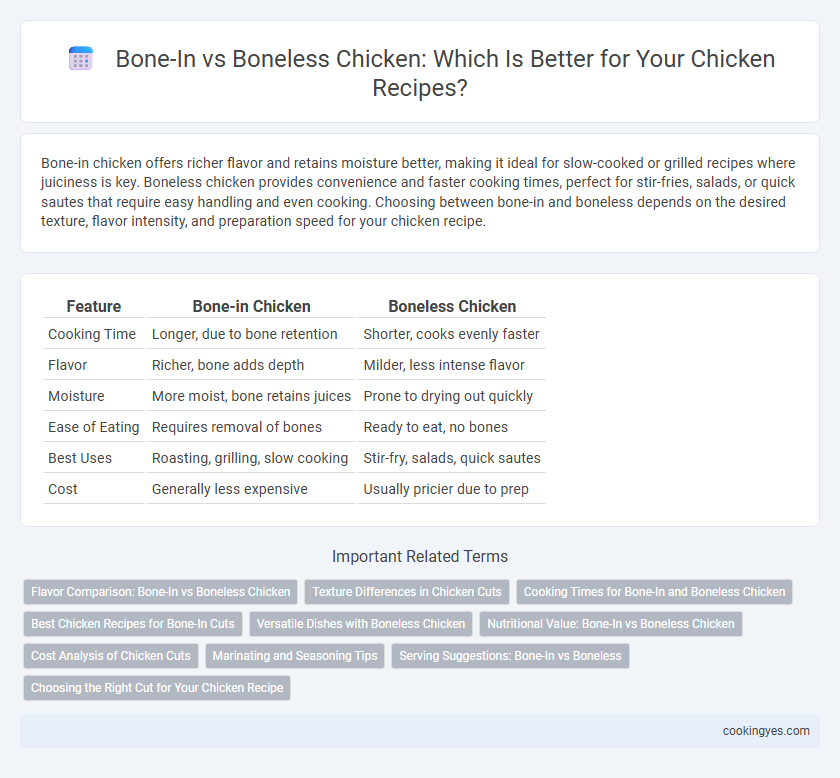Bone-in chicken offers richer flavor and retains moisture better, making it ideal for slow-cooked or grilled recipes where juiciness is key. Boneless chicken provides convenience and faster cooking times, perfect for stir-fries, salads, or quick sautes that require easy handling and even cooking. Choosing between bone-in and boneless depends on the desired texture, flavor intensity, and preparation speed for your chicken recipe.
Table of Comparison
| Feature | Bone-in Chicken | Boneless Chicken |
|---|---|---|
| Cooking Time | Longer, due to bone retention | Shorter, cooks evenly faster |
| Flavor | Richer, bone adds depth | Milder, less intense flavor |
| Moisture | More moist, bone retains juices | Prone to drying out quickly |
| Ease of Eating | Requires removal of bones | Ready to eat, no bones |
| Best Uses | Roasting, grilling, slow cooking | Stir-fry, salads, quick sautes |
| Cost | Generally less expensive | Usually pricier due to prep |
Flavor Comparison: Bone-In vs Boneless Chicken
Bone-in chicken delivers richer flavor due to marrow and connective tissues that release intense, savory notes during cooking. Boneless chicken offers convenience and quicker cooking times but can result in milder taste and less moisture retention. Choosing bone-in enhances depth and juiciness, essential for slow-cooked recipes and robust marinades.
Texture Differences in Chicken Cuts
Bone-in chicken cuts retain moisture during cooking, resulting in juicier and more flavorful meat with a firmer texture near the bone. Boneless chicken, typically skinless, offers a more uniform texture and cooks faster, making it ideal for dishes requiring tenderness and easy slicing. Understanding these texture differences aids in selecting the right cut for recipes like grilled chicken, stews, or stir-fries.
Cooking Times for Bone-In and Boneless Chicken
Bone-in chicken requires longer cooking times, typically 35 to 45 minutes at 375degF, as heat penetrates slowly through the bone. Boneless chicken cooks faster, usually within 20 to 30 minutes under the same temperature, due to direct heat contact with the meat. Adjust cooking times according to the thickness of the chicken pieces to ensure proper internal temperature, aiming for 165degF for safe consumption.
Best Chicken Recipes for Bone-In Cuts
Bone-in chicken cuts deliver richer flavor and juicier texture due to the marrow and connective tissues that release moisture during cooking. Recipes like roasted whole chicken, slow-cooked chicken thighs, or grilled drumsticks excel by maintaining tenderness and enhancing taste complexity. For best results, allow the bone-in meat to cook longer at moderate temperatures, ensuring even heat distribution and depth of flavor.
Versatile Dishes with Boneless Chicken
Boneless chicken offers exceptional versatility in recipes, making it ideal for stir-fries, salads, and quick sautes where ease of cutting and uniform cooking matter. It absorbs marinades efficiently, enhancing flavor in dishes like chicken tikka or grilled chicken skewers. The absence of bones reduces cooking time and simplifies serving, perfect for busy weeknight meals or elegant presentations.
Nutritional Value: Bone-In vs Boneless Chicken
Bone-in chicken often contains more calcium and minerals due to nutrient leaching from bones during cooking, enhancing overall nutritional value. Boneless chicken typically provides a higher protein concentration per serving since it lacks bone mass, making it a leaner option for protein intake. Choosing between bone-in and boneless chicken should consider dietary goals related to mineral intake versus lean protein content.
Cost Analysis of Chicken Cuts
Bone-in chicken cuts typically cost less per pound than boneless cuts due to lower processing and packaging expenses. The presence of bones also adds weight, which can make bone-in pieces appear more economical on a price basis. However, boneless chicken saves preparation time and is often preferred for convenience, potentially offsetting its higher initial cost in recipes.
Marinating and Seasoning Tips
Bone-in chicken enhances flavor absorption during marinating as the bone helps retain moisture and heat, resulting in juicier meat. Boneless chicken requires shorter marinating times, so focus on using acidic ingredients like lemon juice or yogurt to tenderize quickly while seasoning evenly with herbs and spices. For both, apply a balanced mix of salt, garlic, paprika, and pepper to maximize flavor penetration and complement cooking methods.
Serving Suggestions: Bone-In vs Boneless
Bone-in chicken offers richer flavor and moisture retention, making it ideal for slow-cooked recipes like stews and roasted dishes, where the marrow enhances taste. Boneless chicken provides versatile ease and quicker cooking times, perfect for stir-fries, salads, and grilled recipes requiring uniform pieces. Selecting bone-in or boneless depends on desired texture and flavor intensity aligned with specific culinary applications.
Choosing the Right Cut for Your Chicken Recipe
Bone-in chicken offers richer flavor and juiciness due to marrow and connective tissues, making it ideal for slow-cooked dishes like braises and stews. Boneless cuts provide convenience and faster cooking times, perfect for recipes requiring quick preparation such as stir-fries and grilled chicken breasts. Selecting the right cut depends on cooking method, desired texture, and flavor intensity to optimize recipe outcomes.
Bone-in vs Boneless for chicken recipes Infographic

 cookingyes.com
cookingyes.com